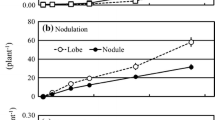Abstract
When excised root nodules ofCoriaria arborea are assayed for nitrogenase activity at various pO2 they show a broad optimum between 20 and 40 kPa O2, with some evidence for adaptation. Continuous flow assays of nodulated root systems of intact plants indicate that Coriaria shows an acetylene induced decline in nitrogenase activity. When root systems were subject to step changes in pO2 nitrogenase activity responded with a steep decline followed by a slower rise in activity both at lower and higher than ambient pO2. Thus Coriaria nodules are able to adapt rapidly to oxygen levels well above and well below ambient. Measurement of nodule diffusion resistance showed that the adaptation is accompanied by rapid increase in resistance at above ambient pO2 and decrease in resistance at below ambient pO2. Plants grown with root systems at pO2 from 5–40 kPa O2 did not differ in growth or nodulation. The anatomy of Coriaria nodules shows they have a dense periderm which encircles the nodule and also closely invests the infected zone. The periderm is both thicker and more heavily suberised in nodules grown at high pO2 than at low pO2. Vacuum infiltration of India ink indicates that oxygen diffusion is entirely through the lenticel and via a small gap adjacent to the stele.
Similar content being viewed by others
References
Calvert H E, Chaudhary A H and Lalonde M 1979 Structure of an unusual root nodule symbiosis in a non-leguminous herbaceous dicotyledon.In Symbiotic Nitrogen Fixation in the Management of Temperate Forests. Eds. J C Gordon, C T Wheeler and D Perry, pp 474–475. Forest Research Laboratory, Oregon State University Press, Corvallis, Oregon.
Hunt S, King B J, Canvin D T and Layzell D B 1987 Steady and nonsteady state gas exchange characteristics of soybean nodules in relation to the oxygen diffusion barrier. Plant Physiol. 84, 164–172.
Johansen D A 1940 Plant Microtechnique. McGraw-Hill Book Co., London.
Minchin F R, Witty J F, Sheehy J E and Müller M 1983 A major error in the acetylene reduction assay: Decrease in nodular nitrogenase activity under assay conditions. J. Exp. Bot. 34, 641–649.
Newcomb W and Pankhurst C E 1982 Fine structure of actinorhizal root nodules ofCoriaria arboera (Coriariaceae). N. Z. J. Bot. 20, 93–102.
O'Brien T P and Carr D J 1970 A suberised layer in the cell walls of the bundle sheath of grasses. Aust. J. Biol. Sci. 23, 275–87.
Pankhurst C E and Sprent J I 1975 Effects of water stress on the respiratory and nitrogen-fixing activity of soybean root nodules. J. Exp. Bot. 26, 287–304.
Parsons R, Silvester W B, Harris S, Gruijters W T M and Bullivant S 1987 Frankia vesicles provide inducible and absolute oxygen protection for nitrogenase. Plant Physiol. 83, 728–731.
Sheehy J E, Minchin F R and Witty J F 1983 Biological control of resistance to oxygen flux in nodules. Ann. Bot. 52, 565–571.
Silvester W B 1977 Dinitrogen fixation by plant associations excluding legumes.In A Treatise on Dinitrogen Fixation. Eds. R W F Hardy and A H Gibson. pp 141–190. John Wiley & Sons, New York.
Silvester W B, Silvester J K and Torrey J G 1988a Adaptation of nitrogenase to varying oxygen tension and the role of the vesicle in root nodules ofAlnus incanna ssp.rugosa. Can. J. Bot. 66, 1772–1779.
Silvester W B, Whitbeck J, Silvester J K and Torrey J G 1988b Growth, nodule morphology and nitrogenase activity ofMyrica gale grown with roots at various oxygen levels. Can. J. Bot. 66, 1762–1771.
Smith G S, Johnston C M and Cornforth I S 1983 Comparison of nutrient solutions for growth of plants in sand culture. New Phytol. 94, 537–54.
Tjepkema J D 1979 Oxygen relations in leguminous and actinorhizal nodules.In Symbiotic Nitrogen Fixation in the Management of Temperate Forests. Eds. J C Gordon, C T Wheeler and D Perry. pp 175–186. Forest Research Laboratory, Oregon State University Press, Corvallis, Oregon.
Tjepkema J D 1983 Oxygen concentration within the nitrogenfixing root nodules ofMyrica gale. Am. J. Bot. 70, 59–63.
Tjepkema J D, Schwintzer C R and Monz C A 1988 Time course of acetylene reduction in nodules of five actinorhizal genera. Plant Physiol. 86, 581–583.
Weisz P R and Sinclair T R 1987a Regulation of soybean nitrogen fixation in response to rhizosphere oxygen. I. Role of nodule respiration. Plant Physiol. 84, 900–905.
Weisz P R and Sinclair T R 1987b Regulation of soybean nitrogen fixation in response to rhizosphere oxygen. II. Quantification of nodule gas permeability. Plant Physiol. 84, 906–910.
Weisz P R and Sinclair T R 1988 A rapid non-destructive assay to quantify soybean nodule gas permeability. Plant and Soil 105, 69–78.
Winship L J and Tjepkema J D 1985 Nitrogen fixation and respiration by root nodules ofAlnus rubra Bong: Effects of temperature and oxygen concentration. Plant and Soil 87, 91–107.
Author information
Authors and Affiliations
Rights and permissions
About this article
Cite this article
Silvester, W.B., Harris, S.L. Nodule structure and nitrogenase activity ofCoriaria arborea in response to varying pO2 . Plant Soil 118, 97–109 (1989). https://doi.org/10.1007/BF02232794
Issue Date:
DOI: https://doi.org/10.1007/BF02232794




